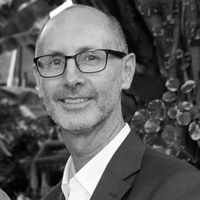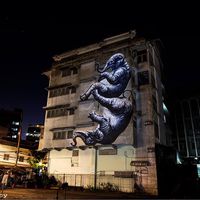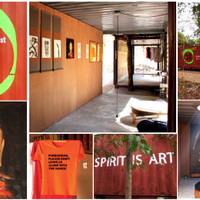By people / In cities: Bangkok | city profile
 This month culture360 contributor David Fernandez introduces the Thai capital city Bangkok. In this article he describes the current panorama of contemporary arts & culture, focusing mainly on the creative industries and especially in the generation of new alternative platforms of creative expression that are starting to attract international attention, apart from other renowned public-funded cultural outlets.
This month culture360 contributor David Fernandez introduces the Thai capital city Bangkok. In this article he describes the current panorama of contemporary arts & culture, focusing mainly on the creative industries and especially in the generation of new alternative platforms of creative expression that are starting to attract international attention, apart from other renowned public-funded cultural outlets. Bangkok, Thailand´s bustling capital city, Southeast Asia’s second largest with 11m inhabitants, is trying to reinvent itself for the 21st century. Under the constant political turmoil and pressure from newly industrialized neighboring countries, Thailand´s authorities have tried to shift its future development direction from the previous industrialized led to the creative driven economy. As a result, the multi-faceted Thai metropolis has changed dramatically over the past years, turning into a creative environment that is different from what most people outside the country would expect.
Bangkok's fast growth has caused a stark contrast between traditional and contemporary lifestyles. Following the financial crisis in 1997, Bangkok local officials quickly accepted the prescription that creative economy is fast-growing, value-adding and essential to economic development, and that creative people need special environments to flourish.
Nowadays, those conditions are clearly visible on the case of Bangkok, both by fostering creative industries such as design, fashion, film and gastronomy and drawing creative workforce from around the world. At the same time, it highlights also the increasing importance of the creative industries as an artistic and cultural expression, and recalls that they constitute an essential element of tourism, one of the main sectors in Thailand.
Moreover, the rise of creative collectives of highly educated and innovative people in Bangkok is noticeably shown as agents of change that replace and supports local governments as the engine of local development. Bangkok’s creative class is an active and dynamic community that enjoys customizing new global trends while revisiting local cultural heritage, presenting Bangkok as a hotbed of creativity, constantly redefining its cityscape as well as its cuisine, fashion and contemporary art scene.
“Bangkok possesses excellent conditions for incubating art scenes as it is relatively cheap, resources are of a good quality and the city isn't zoned so carries a certain visceral and dynamic interest that should feed the creative mindset. – Brian Curtin, Independent Curator and art lecturer.”
Creative Bangkok
Since the late 2000s, primarily two public cultural institutions have been pushing the local creative/cultural scene: Thailand Creative Design Centre (TCDC) and Bangkok Art Cultural Centre (BACC). Both emerged with the aim of fostering creative and cultural exchanges, connecting creativity with business practices, promote cultural tourism and establish creative networks in Bangkok.
On one hand, since opening its doors back in 2006, TCDC has taken on the task of laying the groundwork for creativity stimulation and providing a knowledge center for Thai society, but also promoting "Creative Thailand”, a campaign to raise public awareness towards the creative economy concept and to promote the creative entrepreneurs as the key element of Thai economic driving force.
On the other hand, BACC, the hub of Bangkok’s burgeoning art scene, remains the catalyst of art and cultural understanding as well as a meeting place for artists, to provide arts & cultural programmes for the local community. The Center is considered today an invaluable hive to experiment, to open new grounds for regional cultural dialogue and networking and to create new cultural resources from both the public and the private sectors. It has been also intended as a venue for cultural exchange, giving Bangkok an operational base on the international art scene that has yet to reach regional significance.
According to Ms. Nunnaree Panichkul, Senior Curator at Thailand Creative & Design Center “the cultural scene vibrant and colourful; I think we have seen many interesting projects happening around Bangkok, big and small, with a wide range of activities from plays to performance, from a small degree shows to full-scale exhibitions. More players and more spaces are making our city a place where you can enjoy all kinds of creative fun, if you know where and when to look for.”
Fragmented Arena
Despite TCDC and BACC consistent long-termed efforts, it seems like most top-down official attempts to centralize Bangkok’s creative scene have inevitably failed in the last decade. In contrast, a noticeable evolution has been experienced in regards the art & cultural contexts in Bangkok, mainly due to the fact that at large number of small, independent multi-disciplinary art spaces have been emerging lately all over the city.
I think the scene is fragmented, in terms of geography and communities. There’s still quite a divide between Thai and foreign creative communities, but it’s not black and white, and there’s a lot of crossovers. This growth feels organic; it doesn’t feel overly competitive or territorial, either. It’s quite cool that on a good night you can have a handful of “must-see” art events worth zipping all over town for. - Carl Dixon, Deputy Editor at BK Magazine
It is the case of Soy Sauce Factory, Thonglor Art Space, Brownstone Studios, The Jam Factory Bridge, Studio Lam, CEO Books and Cho Why to name just a few of the recent additions to the Bangkok creative map – plus earlier ones like The Reading Room, The Space, WTF and Speedy Grandma. All very remarkable yet inspiring interdisciplinary outlets that evidence Bangkok´s current cultural resurgence and how the emerging creative community is responding to the traditional shortage of dialogue between music, theatre, film, visual art and other creative fields in Bangkok. Although in recent years the city has gone through very dramatic circumstances, the shared feeling is that Bangkok holds genuine potential and has still plenty of margin for creative development, not exempt from significant challenges.
The creative community in Bangkok is as vibrant as it has always been but maybe less so because of the ups and downs of the political situation in the past decade. My main issue with the creative community is that it hasn't engaged critically and creatively in Thailand's sociopolitical climate that much (if at all). There are indeed some interesting and relevant works from the film community during the past few sociopolitical upheavals and their aftermath, but not much else from practitioners in other creative fields. This suggests a creative community/industry that is strangely apolitical and moderate (as opposed to the universal impression of the arts/cultural community as progressive/subversive). - Kyo Pathomvat, Director at The Reading Room Director / Art Lecturer
At a certain level, all the above-mentioned groundbreaking platforms are succeeding, with very little public support, to regenerate the local scene by stimulating cross-discipline collaboration between different local artivists and push the boundaries of Bangkok´s creative fields by taking art out of the box, exploring, provoking and inspiring while catering unconventional, challenging initiatives for a culturally savvy but still very niche audience.
I think it's amazing that despite a total lack of support from the government and very little funding the community is growing. There are plenty of new spaces that are run by a small group of very dedicated and hard-working artists who struggle to survive financially... yet keep on producing work. I think this very clearly shows the determination and spirit of the creative community in Bangkok. Nana Dakin, Performer and Co-Founder of B-Floor Theatre.
Despite the lack of public funding and the overly niche audience, thanks to the determination of this new emerging network of independent cultural players, and simultaneously to the established network of platforms, as well as other foreign cultural institutions - including Japan Foundation, Alliance Française and Goethe Institut - that continue to steadily nurture and support local creative development, Bangkok has become an ‘eventful’ city, able to start raising awareness in the global creative city networks while shaping this fresh perception that seeks new dimensions for its very own cultural cityscape.
Consequently, it is fair to admit Bangkok is still at the beginning of its arc toward being a leading creative city, in transit from publicly-funded traditional culture to the self-sufficient innovative cultural industries, but poised to establish itself as a hub within the global arena in the next decade, moving from the metropolitan creative city of the country to a cosmopolitan creative city of the world.
Bangkok's cultural scene continues to plant small flags in small venues in the cracks between a hyper-commercialized mainstream and traditional arts that have been memorialized but also lack support. In a climate so antagonistic to serious commentary – and to innovation – most creativity dwells on design or decorative arts, and avoids serious topics, favouring romantic, everyday, Buddhist, supernatural, comedic or nostalgic themes. Art and theatre have had the most leeway – mass-audience film, TV and writing the least – but even coded symbolism is finding limits. The flourishing I've witnessed here are at a low ebb right now. It's not clear what might emerge as the next wave. – Phillip Cornwell-Smith, Author of Very Thai and editor of Time Out.
Started in 2012, By people / In cities is a series of articles and interviews that aims to enhance the understanding of art and culture in Southeast and East Asia through individual stories and perspectives including artists, cultural practitioners, and policy makers.
Sources:
- UNESCO: http://en.unesco.org/
- TCDC: www.tcdc.or.th/
- BACC: www.bacc.or.th/
- CREATIVE THAILAND: http://www.tcdc.or.th/creativethailand/
- BK Magazine: http://bk.asia-city.com
- BANGKOK ART MAP: https://www.facebook.com/bangkokartmap
- VERY THAI: http://www.verythai.com/
David Fernández is a Spanish-born contributing writer based in Bangkok, Thailand. Currently working as freelance arts & cultural project manager and digital media consultant for EUNIC Bangkok, he is also one of the co-founders of Cho Why multi-disciplinary project space. He previously co-founded Le Cool Bangkok arts & culture webzine and worked as content director. Formerly, he served as cultural attaché at the Embassy of Spain – Cultural Office in Bangkok.
Similar content
posted on
30 Jun 2015






